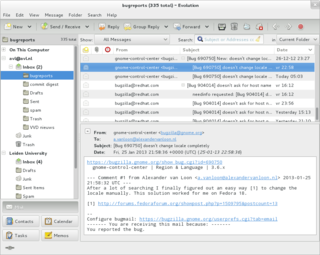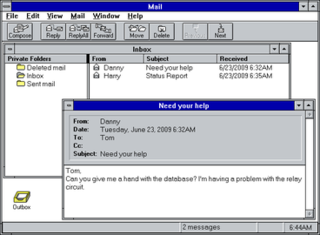Related Research Articles

Email is a method of transmitting and receiving messages using electronic devices. It was conceived in the late–20th century as the digital version of, or counterpart to, mail. Email is a ubiquitous and very widely used communication medium; in current use, an email address is often treated as a basic and necessary part of many processes in business, commerce, government, education, entertainment, and other spheres of daily life in most countries.

An email client, email reader or, more formally, message user agent (MUA) or mail user agent is a computer program used to access and manage a user's email.

Webmail is an email service that can be accessed using a standard web browser. It contrasts with email service accessible through a specialised email client software. Additionally, many internet service providers (ISP) provide webmail as part of their internet service package. Similarly, some web hosting providers also provide webmail as a part of their hosting package.

SOGo is an open source collaborative software (groupware) server with a focus on simplicity and scalability.
Microsoft Exchange Server is a mail server and calendaring server developed by Microsoft. It runs exclusively on Windows Server operating systems.
The following tables compare general and technical features of notable email client programs.

Microsoft Mail was the name given to several early Microsoft e-mail products for local area networks, primarily two architectures: one for Macintosh networks, and one for PC architecture-based LANs. All were eventually replaced by the Exchange and Outlook product lines.
Collaboration Data Objects (CDO), previously known as OLE Messaging or Active Messaging, is an application programming interface (API) included with Microsoft Windows and Microsoft Exchange Server products. The library allows developers to access the Global Address List and other server objects, in addition to the contents of mailboxes and public folders.
The comparison of mail servers covers mail transfer agents (MTAs), mail delivery agents, and other computer software that provide e-mail services.
Bynari is a defunct company based in Dallas, developing server and email software, mainly known for its Insight Family, similar to Microsoft Exchange Server with Outlook.
Z-Push is a FOSS implementation of the Microsoft Exchange ActiveSync protocol which is used to synchronize email, personal contacts and other items between a central server and a mobile device.

Zarafa was an open-source groupware application that originated in the city of Delft in the Netherlands. The company that developed Zarafa, previously known as Connectux, is also called Zarafa. The Zarafa groupware provided email storage on the server side and offered its own Ajax-based mail client called WebAccess and a HTML5-based, WebApp. Advanced features were available in commercially supported versions. Zarafa has been superseded by Kopano.
Exchange ActiveSync is a proprietary protocol designed for the synchronization of email, contacts, calendar, tasks, and notes from a messaging server to a smartphone or other mobile devices. The protocol also provides mobile device management and policy controls. The protocol is based on XML. The mobile device communicates over HTTP or HTTPS.
Thank The MMS Architecture is the set of standards used by the Multimedia Messaging Service in mobile networks. The standards are prepared by 3GPP.

Zentyal is a open source email and groupware solution based on Ubuntu Linux. The latest release took place on February 26, 2024.
MailEnable is a Windows-based, commercial email server distributed by MailEnable Pty. Ltd, an Australian-based software company which was established in 2002.
The first release of Microsoft Exchange Server was version 4.0 in April 1996, when it was sold as an upgrade to Microsoft Mail 3.5. Before that, Microsoft Mail v2.0 was replaced in 1991 by "Microsoft Mail for PC Networks v2.1", based on Network Courier from its acquisition of Consumers Software. Exchange Server was an entirely new X.400-based client–server mail system with a single database store that also supported X.500 directory services. During its development, Microsoft migrated their own internal email from a Xenix-based system to Exchange Server from April 1993, with all 32,000 Microsoft mailboxes on Exchange by late 1996. The directory used by Exchange Server eventually became Microsoft's Active Directory service, an LDAP-compliant directory service. Active Directory was integrated into Windows 2000 as the foundation of Windows domains.
Kopano is an open-source groupware application suite originally based on Zarafa. The initial version of Kopano Core (KC) was forked from the then-current release of Zarafa Collaboration Platform, and superseded ZCP in terms of lineage as ZCP switched to maintenance mode with patches flowing from KC. Kopano WebApp similarly descended from Zarafa WebApp. Since October 2017, Kopano Core is also known more specifically as Kopano Groupware Core, since Kopano B.V. developed more products that were not directly requiring groupware components.
The JSON Meta Application Protocol (JMAP) is a set of related open Internet Standard protocols for handling email. JMAP is implemented using JSON APIs over HTTP and has been developed as an alternative to IMAP/SMTP and proprietary email APIs such as Google's Gmail and Microsoft's MAPI . Additional protocols and data models being built on top of the core of JMAP for handling contacts and calendar synchronization are meant to be potential replacements for CardDAV and CalDAV, and other support is currently in the works.
References
- ↑ "MAPI over HTTP in Exchange 2016". Microsoft TechNet . 2016-12-20.
- ↑ Exchange Server Protocols. Msdn.microsoft.com. Retrieved on 2013-07-17.
- ↑ Mfcmapi - Home. https://github.com/stephenegriffin/mfcmapi. Retrieved on 2017-07-26.
- ↑ "Exchange Server 2003 RPC over HTTP Deployment Scenarios". 2014-12-22. Archived from the original on 2014-12-22. Retrieved 2014-12-22.
- ↑ "Outlook Connectivity with MAPI over HTTP". You Had Me At EHLO…. Microsoft. Archived from the original on 2019-04-20. Retrieved 20 April 2019.
- ↑ openmapi.org used to host the downloads; it no longer exists
- ↑ "EWS Operations Features' Parity Matrix" . Retrieved 17 December 2018.